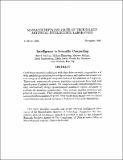Browsing AI Memos (1959 - 2004) by Author "Katzenelson, Jacob"
Now showing items 1-6 of 6
-
Computational Structure of the N-body Problem
Katzenelson, Jacob (1988-04-01)This work considers the organization and performance of computations on parallel computers of tree algorithms for the N-body problem where the number of particles is on the order of a million. The N-body problem is ... -
Intelligence in Scientific Computing
Abelson, Harold; Eisenberg, Michael; Halfact, Mathew; Katzenelson, Jacob; Sacks, Elisha; e.a. (1988-11-01)Combining numerical techniques with ideas from symbolic computation and with methods incorporating knowledge of science and mathematics leads to a new category of intelligent computational tools for scientists and ... -
A Network Charge-Orineted MOS Transistor Model
Katzenelson, Jacob; Unikovski, Aharon (1995-08-01)The MOS transistor physical model as described in [3] is presented here as a network model. The goal is to obtain an accurate model, suitable for simulation, free from certain problems reported in the literature [13], and ... -
Software Structuring Principles for VLSI CAD
Katzenelson, Jacob; Zippel, Richard (1987-12-01)A frustrating aspect of the frequent changes to large VLSI CAD systems is that so little of the old available programs can be reused. It takes too much time and effort to find the reusable pieces and recast them for ... -
The Supercomputer Toolkit and Its Applications
Abelson, Harold; Berlin, Andrew A.; Katzenelson, Jacob; McAllister, William H.; Rozas, Guillermo J.; e.a. (1990-07-01)The Supercomputer Toolkit is a proposed family of standard hardware and software components from which special-purpose machines can be easily configured. Using the Toolkit, a scientist or an engineer, starting with a ... -
The Supercomputer Toolkit: A General Framework for Special-purpose Computing
Abelson, Harold; Berlin, Andrew A.; Katzenelson, Jacob; McAllister, William H.; Rozas, Guillermo J.; e.a. (1991-11-01)The Toolkit is a family of hardware modules (processors, memory, interconnect, and input-output devices) and a collection of software modules (compilers, simulators, scientific libraries, and high-level front ends) from ...





